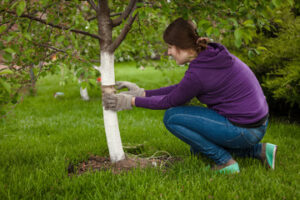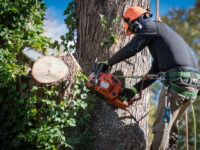Tree Health And Disease Management
Managing tree health and disease requires new thinking. Trees and their environments are always in flux, and any one treatment can have a ripple effect on everything else around them.
Common symptoms of diseases include slowed growth, discolored leaves or needles, progressive twig and branch dieback, undersized fruit or seed production, or fungus “fruiting” on limbs or stems. Getting professional assistance from PRV Tree Service can save you time and money.
 Insects
Insects
Insects are a part of nature and can be helpful in the ecosystem by aiding bacteria, fungi, and other organisms that decompose organic material. They also pollinate plants and serve as predators of more harmful insects. However, their presence in urban landscapes can be a significant problem because of their impact on tree health and function. Often, the damage they cause is more serious than the impact of other factors that expose trees to insect problems – such as primary environmental stresses like drought, soil compaction, construction damage, and lightning.
In addition to the obvious effects, such as discoloration and leaf deformities, insect outbreaks can result in wilting and withering, twig dieback and crown thinning, bark blisters, lesion marks, lesions, cankers, and other defects. Many urban tree species are particularly susceptible to disease and insect damage. Therefore, regular inspections by a certified arborist are important to identify signs of stress that can lead to insect and disease problems.
The impacts of insect pests and pathogens on tree health and function have been extensively studied in both forest ecosystems and the urban environment. Invasive tree insects have a major impact on ecosystems because they can alter litter chemistry, carbon storage, and nutrient cycling (Liebhold et al., 1995; Lovett et al., 2010).
Some invasive pests have become so familiar that their names are in the public vernacular: gypsy moth, chestnut blight, Dutch elm disease, and others. The rate of new pest introductions has increased with increases in global trade and travel and, despite efforts to control them, their impact on forests and urban tree health is growing.
Infestations of common, nuisance, and damaging insects can be difficult to control because they occur cyclically and are often exacerbated by other stressors. For example, the linden and tulip tree aphids (Eucallipterus tiliae and Illinoia tulipae) create a big problem in urban landscapes because their sticky excrement, known as honeydew, drops from the canopy and collects on surfaces below – sidewalks, cars and park benches. Horticultural oil or insecticidal soap are effective treatments.
Other diseases, such as powdery mildew and Phytophthora root rot, are less easily identified because symptoms can be similar to those caused by other conditions. Again, a comprehensive, integrated approach is needed to manage these issues and prevent the loss of valuable urban trees. A company operates a state-of-the-art diagnostic laboratory to ensure the proper identification and treatment of these problems.
Diseases
Tree pests and diseases cause significant economic losses for the forestry, timber, and plant-based industries. They also threaten woodland biodiversity, ecosystems, and native species. They are exacerbated by stressors such as cold weather, air pollution, and soil salinity.
Most disease symptoms are the result of interactions between fungi and their host. Those that attack conifers include root rots (e.g. Heterobasidion annosum), bark cankers, and stem cankers. Other diseases that affect conifers include needle cast and spruce beetle damage to needles. Non-living stress factors also contribute to tree health and may aggravate disease symptoms. These include frost damage to buds, crowns, and needles, spring foliation and woody growth, winter flecking of needles, and fungus-induced rot or bark discoloration.
While the natural resistance of forest trees to disease is generally high, climate change influences pathogen initiation and onset as well as their overwintering success. For instance, warmer temperatures and wetter conditions will encourage decay fungi to start and spread more rapidly, which can lead to higher disease incidence and impact.
Forest disease monitoring is critical at both local and landscape scales. Early detection of departures from historic baselines is essential to implementing disease prevention and mitigation strategies. Local and state monitoring programs are important for identifying deviations from these baseline conditions, as are the regional or national monitoring and forecasting efforts of agencies and other land managers.
The Bureau of Forestry operates a network of field stations and forest research laboratories across the state to support ongoing insect, disease, and stand structure monitoring. We map and collect data on these indicators in both the private and public forests. In addition, we are involved in several field trials to explore alternative forestry practices and techniques that can reduce the impacts of tree disease. The forestry center is a resource for the identification of forest insects and diseases and can provide identifications upon request. Identification requests should be accompanied by a sample of the diseased foliage, big enough to be dissected or cultured if necessary. Samples should not be packed in plastic bags, which can encourage fungus growth and deterioration in transit.
Stress
Trees are resilient, but they’re not invincible. They’re subjected to a host of stresses in the environment that can lead to decline or even death. Stresses can be natural or man-made and often a combination of several factors. These factors can include improper planting, watering, soil compaction and construction near roots, nutrient deficiencies, and exposure to air pollution, road salt, and other contaminants.
When a tree is stressed, it’s weakened and susceptible to disease and insect attacks. Openings in the bark, leaf, and fruit tissues of a stress-weakened tree provide opportunities for pathogens to invade. These opportunistic diseases and insects can cause additional damage and make the existing problems worse.
A healthy, well-established tree can tolerate many environmental stresses, but once these stresses get out of control and tip the balance of a tree’s ability to produce its food through photosynthesis, the tree begins to die. This process is usually gradual and occurs over 2-15 years.
It’s important to look for signs of stress on trees in your landscape. This includes flaking bark, fungi protruding from stems and branches, unusual insects or diseases, wilting leaves, and tender new growth, and reduced overall growth. Generally, symptoms of stress are developed more gradually than the signs of a disease or insect infestation.
In urban environments, human activity accounts for most of the stressors on trees. Improper planting, overwatering, soil compaction and construction, nutrient deficiencies, and exposure to pollutants like air pollution, road salt, and other contaminants are all significant contributors to the declining health of urban and suburban trees. Symptoms of stress on trees include abnormally small leaves, early color change, and leaf drop, branch dieback beginning high in the crown, thinning or erratic foliage pattern, reduced or irregular flowering, and higher than normal fruit or nut production. Fortunately, most of these symptoms can be prevented by proper planting, watering, and maintenance practices.
Pest Control
Many insect infestations and diseases can be controlled without the use of pesticides. Integrated pest management programs at the landscape or forest scale focus on prevention, detection, and monitoring at all levels. This includes soil health, proper planting, proper pruning, and periodic inspections of trees and shrubs for problems that may require treatment.
There are thousands of species of fungi, bacteria, viruses, and insects that inhabit forests. Most of these organisms are beneficial, but a few will have serious negative impacts on tree health. These harmful organisms are held in check by natural enemies and an unfavorable environment, but under certain conditions, their populations can grow to damaging levels.
For instance, the emerald ash borer (EAB) is devastating the ashes in our area. This invasive, non-native pest has the potential to wipe out all ash species in the state of Texas and beyond. This is a serious threat to rural and urban environments. The best way to protect against EAB and other invasive pests is to practice proper plant selection and planting methods before any trees are planted.
Proper plant selection, including consideration of the optimum growing conditions for the species, will minimize disease problems. The choice of a sun-loving rather than shade-tolerant species can help limit shade stress and the extended period of leaf wetness that invites foliar diseases. Planting trees or shrubs in a site that is not too windy, wet, dry, or compacted will also reduce the chance of infection.
Infections are caused by microorganisms such as fungi, bacteria, and viruses or by environmental stresses that weakened plants are more susceptible to. Diseases can be difficult to diagnose and identify since different causal agents can produce similar symptoms. At the company, we have a modern diagnostic laboratory to help identify the cause of your problem and develop effective treatment programs.
Proper plant care practices and regular inspections of your landscape can reduce or eliminate insect and disease infestations. Good horticultural pruning and watering practices will keep trees and shrubs healthy, which can discourage disease activity. Adding the right type and amount of fertilizer will encourage strong root growth, which in turn reduces stress and improves disease resistance. Soil and trunk injections of pesticides can be used to control damaging insects and diseases, but only as a last resort when all other control measures are ineffective.






